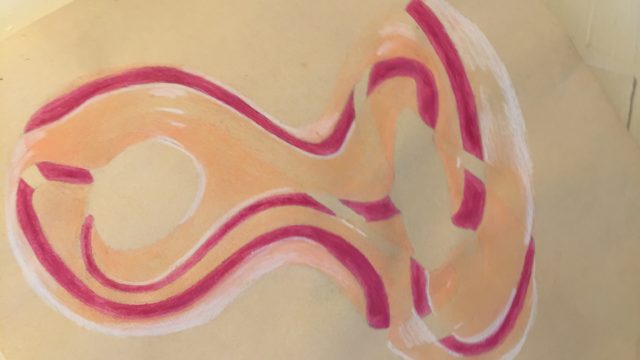
JULY 2017 SUMMER IMMERSION
Summer 2017 Immersion Announcement
Subject: There Is No Lacanian Topology – An Outroduction to Knots, Links, and Borromeans in Psychoanalysis and Mathematics (see course outline below)
Time: begins July 8th, 11:00am-2:00pm and meets every Saturday in July with the last meeting on Aug 5th. Additional courses may be interpolated into the week as the participants see fit.
Place: Euclid St., Santa Monica, CA
Contribution: $400.00 for the entire 5 week immersion.
Registration for the Immersion is advisable in advance since the course is limited to 10 participants. Any questions on registration should be addressed to the administrators at: PLACE@topoi.net.
Instructor: R.T. Groome
Description:
There is no Lacanian Topology –
An Outroduction to Knots, Links, and Borromeans in Psychoanalysis and Mathematics
What is the Summer Immersion? A series of 5 courses, one per week, bringing together importance advances in psychoanalysis and topology.
Why was it started? And what does the instruction have to do with the clinic?
In the market place of knowledge articles and books claiming to address ‘Lacan’s Topology’, ‘Lacanian Topology’, or ‘Lacan and Mathematics’ are now common. Yet, what is discoverable in every such text, especially in the English language, is a hodge-podge of citations, historical commentary, metaphors, and speculative ideas on the clinic that in the end seem to have little to do with topology, mathematics, or the crucial analytic problems. Is there something about psychoanalysis that allows for this discrepancy between its method and truth? At this late date the silliness of the mass publications in Lacanian analysis and topology is evident, at least to anyone who has more than a high-school education. Yet, might there be, with a minimum of good faith, something crucial to be found in the dupery of a psychoanalytic presentation of mathematics that goes beyond mere error and a critique of its pretensions? Or inversely, is there a place where the Non-Dupes-Erre?
However easy it would be to distinguish between a 'bad’ or ‘good’ use of mathematics and psychoanalysis, the question is not there. We take the position that there is simply a symptom or a symptomatic use. Just as there are no bad or good symptoms, the question is not whether there is a good or bad use of mathematics in Lacanian analysis. Rather there is the clinical question of how to avoid a crazy use of mathematics and analysis in general: How can a responsibility be assumed for the practice of topology and psychoanalysis in a way that would not only be closer to the crucial problems brought out by psychoanalysis, but mathematics today? Further still, how can this responsibility be assumed in a way that would not subordinate mathematics or psychoanalysis to a tutelage under a philosophical or scientific framework?
For the last five years the Summer Immersions of PLACE have aimed to give a response to these questions by setting the conditions for an instruction in psychoanalysis and mathematics at the clinical level. Instead of subordinating the psychoanalytic clinic to a therapeutic ideal – as a place where people go to recount their misfortune and suffering to someone who is paid to listen – we define the clinic as a place to confront the difficulties of reading and writing; instead of interrogating the symptom as a pathology within a technique of the mind-body, we situate it with regard to the difficulty encountered in reading and writing time and space. The problem of determining the passage from a physical knot to its diagram-image, then writing this in an algebra while calculating an invariance is one example among many; another would be to determine a way to read the inversions of an object in a mirror image. In short, it is a question of a construction of narcissism, not in the sense of a construction of identifications (= egoism), but of an object.
What is the specific content of the Summer 2017 Immersion? We aim to address the ramifications of a reference to and use of the Borromean not simply in Lacan, but in reference to psychoanalysis and contemporary mathematics. How does this reference and method of working with the Borromean in its diverse titles differ from that of working in ordinary link and knot theory? To be clear, in working in the field of analysis and topology, we will not ask, ‘What is the Borromean in Lacan’s topology?”, just as we will not seek to describe or speculate on possible therapeutic applications of knot theory (with the inevitable comedy of pretensions), rather we situate the difficulty of reading and writing the Borromean from the outset clinically, then seek to respond to a more serious question: Does Lacan’s use of the Borromean in the field of analysis correspond to the same thing that the physicists and mathematicians – from Tait, Debrunner, Brunn, and Milnor – discover before him? If so, then what is it? If not, then how do they differ? Last, it will be important to bring out the difference between the Borromean and the Generalized Borromean in order to clarify the analytic Sinthome. No previous analytic or technical background is presupposed.
Course Outline
1 - A Tertiary Theory: Links, Locks (Borromeans) and Knots
1.1 Methods of Construction: Synthetic and Analytic
1.1.1. Problems of Presentation
1.2. Knot Tables in Mathematics and Psychoanalysis
2. Clinical Correspondances: Neurosis, Perversion, Psychosis, Psychoanalysis
2.1 The Folklore of Knots, Links, and Locks in the Oeuvre of Lacan
2.1.1 A Topology of Primary Repression: The Real/True Hole and the False Hole
2.2. The function of the Sinthome in the work of Lacan and its correspondence to the
mathematical literature.
2.2.1 The Sinthome of Freud and its extensions: Joyce and Schreber.
3. The Generalized Borromean and the Lacan Knot